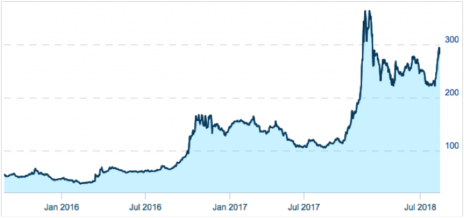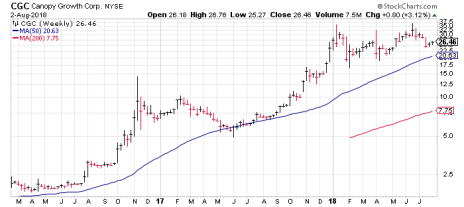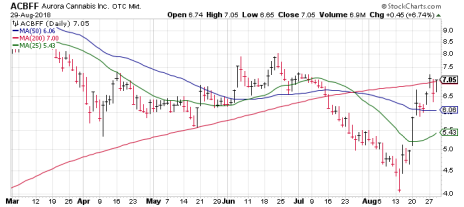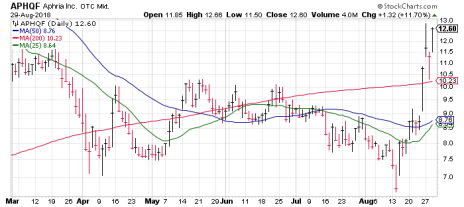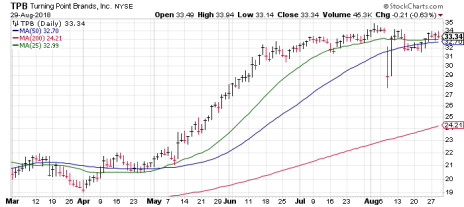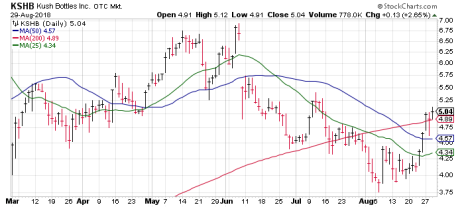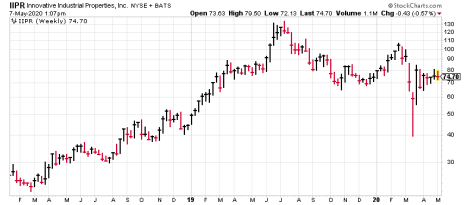As marijuana stocks have blasted off over the past couple of weeks, it’s become clear that institutional money is entering the sector—and this is good. We like having institutions confirm our early judgment that the cannabis industry is a great place to invest, probably the greatest growth sector of our time.
Cabot Marijuana Investor—August 2018
Dear Investor,
Three months ago, when our previous full issue was published, the race for first place in the young and fast-growing cannabis industry was neck-and-neck, with acquisitive Aurora challenging Canopy Growth. But today, in the wake of Constellation Brands’ massive $4 billion investment in Canopy, the gap has widened; Aurora is worth “just” $6 billion, while Canopy is worth $10 billion.
To you, this may not mean much. You just want to be guided to the best cannabis stocks. But the growing interest of Constellation is a sign that established players see big opportunity here—which is exactly what I’ve been saying for the past year!
And it’s also a reminder that if any of the eight alcohol companies that are larger than Constellation get involved, values could easily step higher still! (A rumor last week that Diageo PLC, maker of Smirnoff and Johnny Walker, was in talks with at least three Canadian marijuana companies was one reason for the sector’s current surge.)
But that doesn’t mean the path will be smooth; this remains a young and unpredictable industry, with frequent developments on both the legal side and the corporate side, as the players angle for advantage in what is the fastest-growing industry in America (27% per year).
What is certain is that the legal market for adult-use marijuana in Canada opens October 17—and all the big players are ready. How big demand will be, both on the first day and in the weeks and months thereafter, we will see. Also to be seen is how marijuana prices change as production of what is essentially a commodity adjusts to meet market demand.
But what you want to know is what stocks to buy and—equally important—when.
So, in the following pages you’ll find extensive profiles of my favorite 10 (plus three) stocks in the industry today, along with a few words about investing in each of them.
General Investing Advice
But right here I want to give you some serious advice about investing in the sector as a whole.
The fact that the marijuana industry is the fastest-growing industry in America today means it has the highest potential for investors. But because these stocks are small and the companies are young and trading is often thin and institutional ownership is low, these stocks can be very volatile, so short-term risk is high!
Generally, the best way to defuse short-term risk is to be a long-term investor, and the best way to be a long-term investor is to get in when stocks are low, so you develop some good profits right away. Big profits are a great cushion against volatility.
Which brings me to timing.
Timing
A year ago there was a nice bottom in the sector; that’s when we did our first buying. In January, there was a top; investors who bought then got hurt. (I recommended some selling just a day before the top.)
Marijuana Index
And just two weeks ago, there was another bottom, so buying selectively now will likely work out, particularly if the stock you target has a healthy chart that is not overextended to the upside.
Diversification
Diversification is a key principle of successful investing, so when it comes to the marijuana sector, I suggest that you diversify among at least three stocks, ideally among companies that are in different parts of the industry. Also, I suggest that you commit no more than 10% of your portfolio to marijuana stocks.
And it’s a good idea to, go slow. Don’t make all your investments in one day. Diversify by time.
Evolution
Lastly, and most trickily, make sure that your investing strategy evolves as the industry evolves. A year ago, when the stocks were low-priced and volatile, I found reduced risk by investing in a pharmaceutical company (GWPH), a smokeless tobacco company (TPB) and a packaging company (KSHB)—companies that were not growers but that were benefitting from the industry’s growth—and found not only reduced risk there but also good returns. But as the industry has matured (slightly) and the lower-tier growers have matured (a little) I’ve been investing more directly in the industry. At this point, with U.S. federal law still squarely at odds with the industry, that means leaning even more heavily toward Canada, and I’m wary of going too far in that direction, because when the next big correction comes for those big Canadians growers, I still want diversification.
Final Note
This marks the fifth and last issue in this format. With the next issue, due October 4, we will be shifting to a monthly frequency, and several changes will come with that. Not only will the format be different, there will also be more attention to portfolio allocation. And some of these changes will start now.
As explained in the pages that follow, the portfolio will now sell one-half of its Canopy (CGC) position, sell one-half of its Kush Bottles (KSHB) position, sell one-third of its Innovative Industrial Properties (IIPR) position and sell one-third of its Turning Point Brands (TPB) position. This will leave the portfolio with a cash position of about 20%, which will be used for new buying when decent entry points are identified in the future (they won’t just keep going up, you know).
If you have a specific question, you can email me directly at tim@cabotwealth.com.
Now to the stocks, in order of market capitalization.
Yours for wealth and wisdom,
Timothy Lutts
The portfolio was started with a hypothetical $100,000 on August 22, 2017.
My 10 Best Marijuana Stocks (Plus Three!)
1. Canopy Growth (CGC) (WEED in Canada)
Canopy Growth is once again the most valuable marijuana grower in Canada, thanks to Constellation Brand’s $4 investment on August 15—an investment that not only brought the alcohol company’s interest in Canopy to 40% but also brought them warrants that, if exercised, would take ownership beyond 50%! In other words, Canopy might soon be controlled by Constellation.
That might not be a bad thing. Constellation is an expert at branding and consumer marketing—and already controls shelf space where someday you will be able to buy an adult beverage infused with cannabis—and Canopy is excellent at growing marijuana, at a larger scale than any company on the planet.
At the heart of Canopy’s business is Tweed, the most recognized marijuana production brand in the world. The core of Tweed’s growing operations is in the former Hershey Chocolate factory in Smiths Falls, Ontario, where Canopy has more than 730,000 sq. ft. of greenhouse space dedicated to cannabis production.
Beyond that there’s Bedrocan, the epitome of medical grade marijuana, based on strains developed in Holland over decades. And then there’s Spectrum Cannabis, a unique color-based strength and dosage system that helps users (and doctors) select products based on THC potency and CBD (cannabidiol) levels. CBD is the component of both cannabis and hemp that has no psychoactive effect, but does have numerous medicinal and therapeutic effects.
Other brands under the Canopy umbrella include DNA, Leafs by Snoop, CraftGrow and Foria—and these brands will be available across Canada in October, as Canopy has supply arrangements in every province in the country. In Ontario alone, Canopy will sell 100 SKUs, including pre-rolled joints, dried flower, oils, and softgel capsules. All told, Canopy has 13 facilities across Canada for cultivation, harvesting and processing.
Outside Canada, Canopy already is active in Australia, Brazil, Chile, Columbia, Czech Republic, Denmark, Jamaica, Lesotho, Spain and South Africa, and its plans in these countries are interesting. As CEO Bruce Linton explained at a marijuana conference I attended in New York City, growing marijuana is so easy (there’s a reason it’s called “weed”) that local governments will impose tariffs to imported product to encourage local production instead. So Canopy’s plan is to establish local production wherever possible, ideally before the competition.
In the fiscal first quarter, ended June 30, revenues were $25.9 million, up 63% from the year before. There were no earnings, as the company is still in investment/stockpiling mode. 2,695 kilograms (and kilogram equivalents) of marijuana were sold, up 47% from the previous year. Oil sales, including gel caps, accounted for 26% of revenues, up from 19% the year before. Sales to Germany accounted for 14% of revenue. The average sale price per gram was $8.94, compared to $7.96 the previous year, while the price in Germany was $13.35 per gram. At the end of the quarter, Canopy held inventory of 19,721 kilograms of dry cannabis, 14,895 liters of oils and 1,055 kilograms of softgel capsules.
As to the chart, CGC has been a true leader, breaking out to new highs in June and again in August, shooting ahead 96% on high volume in just nine trading days. Partly this reflects the company’s capable leadership and its industry-leading production capacity, but partly it reflects the fact that CGC trades on the NYSE and is viewed as the least risky investment (thanks to Constellation) in the industry and that it’s therefore the natural place to put institutional money.
But with the stock “up here”, it’s not a safe buy today—at least not in the short term. In fact, I’m going to sell some now, mainly because the stock has grown from 10% of this portfolio at the start to 27% today and that’s a bit heavy. SELL HALF AND HOLD THE REST. For new readers who haven’t bought yet, wait for some type of pullback, and start small.
2. Aurora Cannabis (ACBFF) (ACB in Canada)
Aurora has no big-pocketed suitor like Constellation; instead, it’s been getting big by acquiring competitors and complimentary companies—and by growing its total cultivation space fast.
On the acquisition side, Aurora has bought 10 companies so far: CanvasRx, Canada’s leading counseling service on medical marijuana; Peloton Pharmaceutical, a Canadian grower that was bankrupt; Pedanios, a German company that’s the leading wholesale importer, exporter, and distributor of medical cannabis in the European Union; H2 Biopharma, a grower in Quebec; Urban Cultivator, which makes indoor gardening appliances for the cultivation of organic microgreens, vegetables and herbs in home kitchens; BC Northern Lights, which makes systems for the high-yield indoor cultivation of cannabis; Larssen, a Canadian greenhouse designer; CanniMed Therapeutics, a Saskatchewan leader in medical marijuana: Anandia Labs, an industry leader in science, genetics, and independent cannabis product testing; and MedReleaf.
Additionally, Aurora owns 19.9% of Alcanna (formerly known as Liquor Stores N.A.), which has 220 stores in Canada; holds approximately 17% of the issued shares of leading extraction technology company Radient Technologies; has a strategic investment in Hempco Food and Fiber; has a 22.9% stake in Cann Group Limited, the first Australian company licensed to conduct research on and cultivate medical cannabis; a 17.6% stake in Canadian producer The Green Organic Dutchman; and 6% of Choom Holdings, a leading craft marijuana grower.
In other words, the company has been amassing assets that address every aspect of the industry.
Auroras’s original growing facility is in the foothills of the Rocky Mountains north of Calgary, but the company is also growing in two facilities in Quebec, building an 800,000 sq. ft. facility at the Edmonton International Airport and a 1,200,000 sq. ft. hybrid greenhouse facility in Medicine Hat, plus a million sq. ft. facility for Denmark that will be Europe’s largest cannabis facility.
In fact, Aurora’s goal is to be the biggest producer of marijuana in Europe! To that end, each of Aurora’s facilities is built to meet European Union (EU) GMP standards. All told, Aurora today has operations in 14 countries.
Aurora began the year with an estimated annual production capacity of just over 100,000 kilograms of cannabis, but the rapid pace of acquisitions means it’s now expected to generate 570,000 kilograms a year, when at full capacity. But growing is just the beginning; Aurora expects to add value to much of its crop by processing it into oils, extracts and other differentiating, high-margin products.
Last but not least, Aurora is moving into the U.S.! Sometime in September, it will spin out a U.S. subsidiary named Australia Capital that will invest in U.S. cannabis and real estate assets. Note: I think it’s a bad name; it’s too close to “Australia” and has nothing to do with Australia. Anyway, the goal is to get a jump on what CEO Scott Dowty termed “the undercapitalized and fragmented nature of the U.S. cannabis industry.”
In the quarter ended March 31, Aurora saw revenues of $16.1 million, up 211% from the year before. Loss per share was $0.04. Average selling price per gram was $7.99, while average cost per gram was $1.53.
As to the chart, ACBFF shows little of the leadership qualities of CGC today. Its consolidation since January has been long and deep. Nevertheless, the long-term uptrend remains intact, and the recent surge on high volume shows that investors have not forgotten Aurora—they’ve just been distracted by the leader. If you don’t own it, you could buy a little here, but it would be wiser to wait for a normal pullback, perhaps to 6.
3. Aphria (APHQF) (APH in Canada)
Unlike the first two Canada growers, Aphria cares about earnings; the company has now reported 11 consecutive quarters of positive EBITDA.
The biggest reason for that is that most of the company’s marijuana is grown in greenhouses, in natural sunlight, thus avoiding the substantial costs of lamps and electricity incurred by its competitors. Its location in Learnington, Ontario, which is farther south than Detroit and close to the most southerly point in Canada, is key.
Also key to its profitability is the fact that Aphria has not been acquiring at the speed of Aurora—though it has certainly done smaller acquisitions. But the company has been spending on greenhouses, which will soon add to its product stream. When current projects are complete, the company anticipates that annual production capacity in Canada will be 255,000 kilograms.
Like its bigger competitors, Aphria is expanding internationally. It has complete ownership of Aphria Inc. in Arizona, Nuuvera Israel in Tel Aviv, Nuuvera Deutschland in Hamburg, of FL Group in Genoa, Italy, and 90% ownership of Nuuvera Malta, and an agreement with Colcanna SAS, a Colombia-based pharmaceutical import and distribution company, to import, sell and distribute medical cannabis and derivatives in Colombia.
Back in Canada, Aphria has total ownership of Canaan Growers in British Columbia, Pure Natures Wellness in Ontario, Nuuvera in Ontario, ARA-Avanti Rx Analytics in Ontario, Avalon Pharmaceuticals in Ontario, and a deal with Great North Distributors, a wholly-owned Canadian subsidiary of Southern Glazer’s Wine & Spirits. These companies will serve as the exclusive manufacturer’s representative for Aphria’s adult-use cannabis products throughout Canada.
Moving to the U.S., the company has invested $25 million in an entity named Aphria USA, which will begin operations in Florida by dispensing low-THC medical cannabis to patients in the state of Florida.
When adult-use sales begin October 17 in Canada, Aphria will have 59 different products available in the Ontario market, including Solei, sustainably grown in Ontario, premium B.C.-bud from Broken Coast, and several other Ontario-grown brands soon to be revealed.
In the fiscal second quarter, ended May 31, Aphria’s revenues grew to $12.0 million, up 110% from the year before, while the net loss for the quarter was $0.06 per share, up from $0.02 per share in the prior year. 1,312 kilograms (or kilogram equivalents) of product were sold. And the cost to produce one dried gram of cannabis fell a penny to $0.95.
As to the stock, it’s behaved similarly to Aurora, but better. Not only did it hold up better in the July selling wave, but it’s got a bigger boost in recent weeks and climbed well above its June high. If you haven’t bought yet, wait for a pullback or start small here.
4. Cronos Group (CRON) (CRON.V in Canada)
Cronos is the fifth-largest (by market capitalization) of the Canadian marijuana growers, and like the others, it’s been busy making deals so it can scale up rapidly as the industry prepares for a particularly explosive phase of growth after October 17.
In fact, the opening of the adult-use market will see the launch of COVE, Cronos’ premium brand that was born in the Okanagan Valley in British Columbia, which is known for producing some of the world’s finest cannabis.
At the same time, Cronos will launch Original BC (a lower-priced brand), basically rebranding its medical marijuana product line, dubbed Peace Naturals.
Cronos has also invested in and made loans to Whistler Medical Marijuana Company, Evergreen Medicinal Supply Inc., AbCann Global Corporation, Canopy Growth Corp. and The Hydropothecary Corporation.
And the company has a 49.9% stake in Indigenous Roots, a medical cannabis company that will work cooperatively with Canadian First Nations towards building and operating licensed facilities and providing medical cannabis to First Nations.
On the international side, Cronos has partnered with an Israeli kibbutz (Gan Shmuel) to grow marijuana for the export market. When complete, the project is expected to generate about $160 million a year by producing about 53,000 pounds of cannabis annually.
Cronos Australia is nearly fully licensed to begin full-scale operations in Australia. Cronos has a strategic distribution partnership with Delfarma, a pharmaceutical wholesaler with a distribution network of over 5,000 pharmacies and more than 200 hospitals in Poland. And possibly most important of all, Cronos has a joint venture with MedMen Enterprises USA, to create a Canadian branded retail chain named MedMen Canada. MedMen is the largest cannabis retail chain in California, has assets in Nevada and New York, and may be the most recognized cannabis brand in the world today.
Just last month, the company announced plans to build an 850,000 square foot greenhouse in Kingsville, Ontario that will produce up to 70,000 kilograms of cannabis annually. Additionally, the company entered into a five-year supply agreement with Cura Cannabis Solutions whereby Cura will buy a minimum of 20,000 kilograms of cannabis per year from Cronos. So the future, as with all these companies, is bright.
As to the present, in the second quarter ended June 30, revenues totaled $3.4 million, up 428% from the year before, and cannabis oil, which is more profitable than flowers, accounted for 40% of domestic medical sales. On the inventory side, finished goods inventory and biological assets increased by 46% quarter-over-quarter to 2,451 kilograms as the company prepares for October 17.
As to the chart, the stock didn’t get as overbought in January as the big three, so it bounced strongly in early March when it became the first cannabis stock listed on the Nasdaq exchange—but then it joined the crowd on the downside, and spent the time until August tracing out a beautiful basing pattern. And when the buyers came back to the sector two weeks ago, they quickly shot the stock up to new highs! As with CGC, part of this strength comes from the stock’s availability on a U.S. exchange; nevertheless, it’s a strong positive. If you’re not yet on board, wait for a correction. And if you can’t wait, start small.
5. Hydropothecary (HYYDF) (THCX.V in Canada)
Hydropothecary’s growing capacity is well behind that of the leaders. The company currently produces cannabis in a 300,000 sq. ft. greenhouse and an additional 1 million sq. ft. greenhouse facility should be completed in December. When these expansions are finished, Hydropothecary will be capable of producing 108,000 kg of cannabis per year.
But what the company lacks in quantity, it makes up for in quality, specifically in the product development, package design and branding. In fact, the company’s name will soon change to HEXO Corp., a much more manageable moniker.
As to its products:
Time of Day, its Signature product line, is a series of mixes of dried marijuana buds, designed for different times of the day.
H2 is a line of Classical Medical Marijuana products, identified by strain including Pink OG Kush, Papaya Grove, Dragon Fruit, Juniper Berry, Passion Fruit, Honeydew and Bitter Melon.
Decarb, which was named Best New Cannabis Product at the Lift Canadian Cannabis Awards, is fine milled medical marijuana, designed for oral consumption. Decarb comes in six different products, ranging from high THC to high CBD.
Elixir is a sublingual spray that delivers cannabis oil (either high-THC or high-CBD) mixed in a peppermint spray. Discreet and convenient, it costs more.
Fleur de Lune, launched in July, is intimate medical cannabis oil that is both odorless and tasteless and is apparently designed to enhance sex—though the company can’t say that. What Hydropothecary Vice President of Sales Sonia Isabel could say is, “We’re excited to be launching intimate oil, which is a completely different use for medical cannabis. We believe Canadians will embrace this discreet way to consume their medicine.”
Also in July, Hydropothecary invested $10 million in cannabis retailer Fire & Flower, which has submitted 37 retail store licenses in the province of Alberta, and has been awarded one retail store license in the province of Saskatchewan. This gets Hydropothecary into the retail business.
And then on August 1, the company announced a joint venture with Molson Coors, which sells one-third of the beer in Canada, to develop and market non-alcoholic, cannabis-infused beverages for the Canadian market—once they are legal. The selection of Hydropothecary by Molson Coors is not only a strong vote of confidence in the company, but also guarantees Hydropothecary (soon to be HEXO) excellent exposure on store shelves.
In the quarter ended April 30 (the third quarter of fiscal 2018), revenue was $1.24 million, up 5% from the year before, while the loss per share was $0.01, compared to a loss of $0.17 the year before.
Sales volume in the quarter totaled 134,253 gram equivalents, and average revenue per gram was $9.24 (high for the industry) compared to $8.99 in the prior quarter and $8.62 the year before. Weighted average cost per gram was $0.88, which is low for the industry and the major reason for that is the company’s low electric rates.
As to the stock, like CRON it wasn’t hugely popular in January, so as the news got better through the year, the stock climbed higher, hitting new highs both in June and again in recent weeks. I think you can buy here or on a correction to the 50-day moving average around 3.70.
6. Turning Point Brands (TPB)
Turning Point Brands is an old-school smokeless tobacco company that has been expanding into the marijuana and vaping markets, primarily through acquisitions of the Zig-Zag brand and several vaping brands. In some companies this would be a difficult transition; you can imagine the resistance to these new lines by traditionalists. But at Turning Point Brands, the transition is going swimmingly; the stock was the first in the portfolio to break out to new highs this spring!
And it’s all because of what I like to call the three-legged stool—and good management.
The first leg of the stool, Smokeless Products (chewing tobacco and moist snuff), accounted for 30% of total net sales in the quarter. Revenues were up 10% from the year before (thanks largely to the company’s chain-wide expansion into Dollar General stores), even though the industry as a whole saw volume decline 3%.
The second leg of the stool, Smoking Products, (mainly Zig-Zag papers and cigar wraps) accounted for 36% of total net sales in the quarter. Revenues were up 8.5% from the year before, even as the company deemphasized its low-margin cigar products. Additionally, the company is distributing new Canadian paper products as well as new Zig-Zag Hemp papers that have been met with “positive trade enthusiasm.”
The third leg of the stool, and the most important to us, is NewGen (mainly VaporBeast and Vapor Supply), which accounted for 34% of total net sales in the quarter and grew 18% from the year before. These are not simply products but “complete e-commerce platforms and sales organizations serving the evolving channels of retail electronic vapor distribution,” and they are the key to the company’s future.
Additionally, I will say that I have been very impressed with management’s navigation of the company from the old world toward the new world.
Net sales for the quarter increased 12.5% to a record $81.1 million (surpassing analysts’ estimates), while earnings hit $0.50 per share, beating estimates of $0.49 per share.
Also, on August 7, Turning Point declared a regular quarterly dividend of $0.04 per common share—which translates to a yield of 0.5%.
As to the stock, it’s done great, more than doubling since my recommendation a year ago—and this is not so much a reflection of fast growth at the company (12.5% is not fast compared to marijuana peers) but of the fact that the company is slowly migrating to a new sector, and thus increasingly deserves the valuation multiples of the marijuana sector rather than the tobacco sector. But the chart has slowly flattened out in recent months and my sense is that progress will be slower for the stock from here. Also, the portfolio doesn’t need the “safety” of this stock as much as it did a year ago. So, we will now sell one-third of the position and hold the rest. SELL ONE THIRD
7. OrganiGram Holdings (OGRMF) (OGI in Canada)
Like all the other growers, OrganiGram is expanding; by early 2020 the company aims to be producing over 110,000 kilograms of cannabis per year from fully funded operations.
And like all the others, it’s preparing for the opening of the adult-use market in Canada on October 17. To that end, the company recently launched its adult recreational brand strategy, which includes house brands such as The Edison Cannabis Company, ANKR Organics and Trailer Park Buds (for the value-conscious consumer).
OrganiGram will provide Ontario with 27 separate products including dried flower, pre-rolled product, cannabis oils and the premium offering of the Edison Reserve brand. Additionally, the company has agreements with the provinces of New Brunswick, Prince Edward Island, Manitoba and Alberta.
The company made its first international medical shipment to Australia in July. And OrganiGram announced strategic investments in Hyasynth Biologicals, Alpha-Cannabis Germany, and Eviana, all of which are expected to close in the third quarter.
In the fiscal third quarter ended May 31, revenues grew to $3.7 million, up 95% from the year before, sales of cannabis oil grew 452% from the year before, and sales of dried flower grew 55% from the year before.
Net income was $2.8 million, compared to a loss of $2.3 million in the year before, and earnings per share were $0.21, compared to a loss of $0.02 the year before.
As to the stock, like the other second-tier growers, it wasn’t as overbought in January as the big three, so not only didn’t it need as much cooling off after, but it was able to break out to new highs in early June when the company’s phase 3 expansion received its official cultivation license. After that the stock pulled back exactly to its 200-day moving average (a successful strategy would have been to sell on the good news and buy at support) and as the group surged, it broke out to a new high last Friday. Overall, it’s a good chart, and only slightly overextended. For new buyers, the usual advice applies about starting small and looking for a normal correction.
8. Kush Bottles (KSHB)
Headquartered in California, Kush is the king of marijuana packaging, both wholesale and retail. And it was one of the original members of this portfolio, included to provide some real diversification in the early days.
In the year since then, the stock has more than doubled— which is great—and the company has evolved significantly as well. First it branched out into the pharmaceutical and veterinary industries—which basically use the same containers. And then it acquired a leading manufacturer and distributor of gases used in processing cannabis (butane, propane and iso-butane) and crossed the border into Canada as well.
The goal, according to CEO Nicholas Kovacevich, is to “position Kush Bottles as a one-stop shop for any business looking to operate responsibly within the legal cannabis market.”
Notably, everything Kush does is perfectly legal in every state and province; the company doesn’t touch cannabis itself.
Next, on September 1, the company’s name will become KushCo Holdings, reflecting the company’s shift to a more diversified business model, which offers a broad range of products and services to cannabis and CBD retailers, growers, and producers, as well as the pharmaceutical and veterinary industries.
As to the stock, it’s had a great run over the past year, but in recent months it’s been “heavier” than other stocks in this report, falling below its 200-day moving average and only rallying up to that line as the sector surged in recent weeks.
So, while I remain long-term bullish on the stock, and still value the diversification it provides, I’m going to reduce our position by selling a third of our current holding and holding the cash on the sideline for now. SELL ONE-THIRD.
9. iAnthus Capital (ITHUF) (IAN in Canada)
iAnthus owns and operates growers, processors and dispensaries in six U.S. states—with a strong focus on the East Coast.
In Massachusetts (the Colorado of the East), the company opened its first Boston dispensary in July, and has locations for two more dispensaries secured—all operating under the brand Mayflower. At the close of the quarter, Mayflower was cultivating 4,243 plants, consisting of 38 different strains, and had achieved its desired “perpetual harvest cycle” of 550 plants every 10 days.
In Florida (now the fourth-largest medical marijuana market in the U.S.), the company’s GrowHealthy division has signed seven leases to date with eight more in the pipeline. At the end of the quarter, the company’s cultivation facility housed over 2,900 plants consisting of 36 different strains.
In New York, the company’s Civita division has broken ground on a cultivation and processing facility; has begun construction on the company’s flagship dispensary, located across from Barclay’s Center in Brooklyn (expected to open in Q4), and is negotiating leases for three more dispensaries in Staten Island, Dutchess County and Chemung County, all expected to open in 2019.
And then there’s Vermont, the first state to legalize adult use marijuana via legislative action. Even though there are only 600,000 residents in the state, there’s a large tourist population (about 13 million visitors annually). iAnthus’ brand, GrassRoots Vermont, has a cultivation facility in Brandon capable of producing 200 kilograms of marijuana annually and plans to double that. Additionally, the company plans to begin construction of a dispensary in Williston by the end of the year.
Additionally, out west, the company has Organix in Colorado, which includes both a cultivation facility in Denver and a dispensary in Breckenridge. In Denver the company also has an interest in The Green Solution, with one cultivation facility and 16 dispensaries. And in New Mexico the company has an interest in Reynold Greenleaf, a management service company.
In the six months ended June 30, revenues were $4.9 million, while the loss was $36.2 million, with the biggest part of that being early repayment of $20 million of debt in January. Lastly, the company received a $50 million investment from Gotham Green Partners, which will be used to continue its expansion programs.
As for the stock, ITHUF peaked in January with the sector, bottomed in late March, broke out to new highs in June, and has been consolidating that gain since, with a modest surge over the past few days. It doesn’t dance to the exact same tune as the Canadians, and I think that’s a good thing. You can buy it here.
10. Innovative Industrial Properties (IIPR)
Innovative Industrial Properties is a real estate investment trust (REIT) dedicated to the cannabis industry—and one of the few companies in the portfolio with actual earnings. It’s also the smallest by market capitalization.
But it has provided great diversification for the portfolio since the start a year ago, and delivered a fine profit on the way—because it’s growing fast!
In April, the company acquired 89,000 square foot medical-use cannabis cultivation and processing facility in a sale-leaseback transaction with a subsidiary of Vireo Health, in Pennsylvania.
In May, the company acquired a property in Massachusetts and entered into a long-term lease and development agreement with a subsidiary of PharmaCann LLC.
Subsequent to the end of the quarter, in July, the company acquired a 55,000 square foot cannabis cultivation and processing facility in a sale-leaseback transaction with Holistic Industries, Inc. in Massachusetts.
And in August, the company acquired a property in Michigan and entered into a long-term lease with Green Peak Industries, LLC. That’s a lot of additions in a short time!
Adding it all up, as of August 10, the company owned nine properties in Arizona, Maryland, Massachusetts, Michigan, Minnesota, New York and Pennsylvania, totaling approximately 875,000 rentable square feet (including approximately 114,000 rentable square feet under development), which were 100% leased with a weighted-average remaining lease term of approximately 15 years.
The Company’s average current yield on invested capital for these nine properties is approximately 15.7%.
In the second quarter, the company generated rental revenues of approximately $3.25 million, up 152% from the year before, and net income was approximately $0.17 per diluted share, down from $0.28 the year before. More importantly, adjusted funds from operations (“AFFO”) was approximately $1.7 million, or $0.31 per diluted share.
Last but not least, the company paid its fifth consecutive quarterly dividend of $0.25 per common share on April 16, to stockholders of record as of March 29, for an annual yield of 2.9%.
As to the stock, it peaked on January 2 at 36 (a week before the general marijuana group), bottomed at the end of February, broke out to new highs in May, pulled back to support in July, as has surged 34% in August alone, as investors plow into “safer” marijuana plays. And this is my cue to lighten up, both because I don’t believe the stock can maintain this pace and because I want to put more assets into “real” marijuana stocks. So, I’m going to sell one-third of the position and keep the proceeds in cash for now. SELL ONE-THIRD.
Note: Before you invest in IIPR, I recommend you understand the implications of REIT taxation. One place to start is here.
New Stocks
11. CV Sciences (CVSI)
In my update two weeks ago, I mentioned CV Sciences (CVSI), a stock that impressed me by hitting new highs while the rest of the sector was completing its base. Stocks that break out to new highs first are often the leaders of the next move, so I was intrigued, both by the chart action and the fact that the company (formerly known as CannaVest) claimed to be the #1 supplier of CBD in the U.S.
Back then I wrote, “Aggressive momentum investors could buy here, but there are major risks, particularly given the fact that the stock has no company in its journey to the stars.”
Well, the stock did climb higher over the next four days, but on the fifth day, (with the stock up 90% in those five days!), a short-selling outfit named Citron Research sent a tweet saying, “The total bull case is based on REJECTED patents the company has never disclosed and continues to hype. Securities Fraud?”
Now, Citron is no stranger to us; they make money on the short side and they try to help their case with well-timed communiqués like this. And that day alone, the stock traded from a high of 9.20 to a low of 3.40, so I assume they made some money.
But now the stock is in a major correction pattern, as the market tries to sort out whether there’s any truth to Citron’s claim. And it’s the stock that you should listen to at this point, as the action of the stock over time telegraphs the combined judgment of all the investors who have an interest in the company.
As for the fundamentals, they do look good! CV Sciences operates two distinct business segments.
The first is the consumer product division focused on manufacturing, marketing and selling plant-based CBD products (PlusCBD Oil) to a range of market sectors. At the end of June, the company’s wares were available in 1,968 stores, an 11% sequential increase over the retail store count for the first quarter of 2018.
Eventually, I expect the market for CBD to exceed the market for marijuana, and that’s simply because pain/discomfort is universal. Additionally, I believe people will welcome a product that’s far less dangerous than opioids.
The second is a drug development division focused on developing and commercializing novel therapeutics utilizing synthetic CBD. CV Sciences is not the only company targeting this market; others are focusing on the epilepsy market. But CV Sciences is working to target smokeless tobacco users and “addicts” with a chewing gum that contains both nicotine and synthetic CBD. It’s still in the preclinical phase.
As to finances, the company is rolling! In the second quarter, ended June 30, the company saw revenues of $12.4 million, up 203% from the year before, and earnings of $0.04 per share, up from a loss the year before. That was the second consecutive profitable quarter. And just this month, the company repaid its remaining debt of $850,000, nearly nine months ahead of the original due date.
Back to the chart, which was so intriguing just two weeks ago, it’s now fallen below its 50-day moving average on heavy selling volume, and I don’t recommend trying to catch this falling knife (though 2.50 looks like it might provide support). But I will be watching it carefully and trying, with other investors, to see where the truth lies.
12. Tilray (TLRY)
Tilray is a late arrival to the party, but with a market capitalization of $5.6 billion, it’s certainly made a big splash.
The company was incorporated in Delaware in January 2018, for the sole purpose of holding Decatur Holdings BV, a Dutch limited liability company that owns all the Tilray subsidiaries, both Canadian and international, medical and adult-use.
That complex legal setup means the stock can trade on the Nasdaq market, where it’s easily accessible to a wide range of U.S. investors. In fact, since the stock came public in late July, just six weeks ago, a lot of money has flowed into the stock—and I’m sure that accessibility is one reason for the attraction.
Tilray was the first company to legally export medical cannabis products from North America to Europe and the first company to legally export medical cannabis from North America to Australia and New Zealand—and today, Tilray is one of the leading providers of medical cannabis in Australia and New Zealand for commercial, compassionate access and research purposes. Also, it has a cultivation license from the Government of Portugal to produce products for the EU market; and its products are available at pharmacies in countries throughout the EU.
On August 3, the company announced that a study featuring Tilray 2:100, a medical cannabis oil containing high amounts of cannabidiol (CBD) and conservative amounts of Tetrahydrocannabinol (THC), has shown promising results for children with drug-resistant epilepsy (DRE) due to Dravet Syndrome. Results included “a statistically significant reduction in motor seizures, and an increase in seizure-free days.”
(This news should remind you of Epidiolex, the drug made by GW Pharmaceuticals that was recently recommended for approval by an FDA advisory committee for Dravet syndrome and Lennox-Gastaut syndrome, and will cost upwards of $35,000 per year.)
Tilray 2:100 (I have no pricing info) contains the highest concentration of cannabis-extracted CBD in a medical cannabis product available through Canada’s Access to Cannabis for Medical Purposes Regulations (ACMPR). The company is making Tilray 2:100 available first to pediatric patients through the ACMPR, and as supply increases, the product will be made available to additional patients in need.
Moving on to the adult-use market (previously called recreational), Tilray is positioned to hit the ground running when the gun goes off on October 17, with a wide array of products and brands.
Marley Natural is crafted with deep respect for wellness and the positive potential of the herb, Marley Natural offers four categories of cannabis whole-flower and pre-rolls; Marley Green (hybrid), Marley Gold (sativa), Marley Red (high-CBD) and Marley Black (indica).
Irisa is a women’s wellness brand, offering a collection of thoughtfully crafted cannabis products including pre-rolls, sublingual drops and massage oil.
CANACA offers the best of Canadian bud in a variety of celebrated cannabis strains available in whole-flower and pre-rolls.
GRAIL targets the luxury segment of premium craft product, focusing on products derived from rare strains with exotic cannabinoid and terpene profiles.
WALLOPS are cannabis-infused edible chews and hard candies with intense flavor profiles.
DUTCHY targets the more frequent, price-conscious consumer, with pre-rolls, oil cartridges and vaporizers.
GOODSHIP is an edibles brand crafted from premium all-natural ingredients. Products include brownies, cookies and mints.
HEADLIGHT targets more experienced consumers, offering higher potency products including cannabis concentrates, waxes and oils.
In the quarter ended June 30, revenues were $9.7 million, up 95.2% from the year before. Total kilogram equivalents sold increased 97% to 1,514 kilograms.
As to the chart, Tilray was initially listed on the Nasdaq in July 18, which is why it’s just appearing here for the first time. It broke out to new highs on August 20, and over the past two weeks it’s doubled (again, the easy access of the U.S. exchange is a factor). Thus, like all these stocks, there’s serious potential for a pullback. On the other hand, given that the stock is so young, there are still plenty of potential buyers likely to step in on any softness. I’ll be looking for an entry point for the portfolio.
13. MedMen Enterprises (MMNFF) (MMEN in Canada)
MedMen is the leading dispensary operator in U.S., with 19 facilities ranging from cultivation to manufacturing to retail in three key states: California, Nevada and New York.
The company’s strategy is to be vertically integrated in every market, with the ultimate objective being better margins and overall control of the supply chain. During the fiscal fourth quarter, ended June 30, the company opened Project Mustang, a 45,000-square-foot cultivation and manufacturing facility in northern Nevada. The same factory design is currently being built in Desert Hot Springs, California, with completion scheduled for early 2019. And the Company plans to build the same factories in New York, where it currently holds one of 10 medical marijuana licenses, and near Orlando, Florida, provided it closes the acquisition of a Florida license holder with rights to open 25 stores in the state.
Back in California, (a very competitive market in these early days), the company says its stores, which target the high end of the market, accounted for roughly 6% of all legal retail sales of cannabis and cannabis products in the state in the second quarter.
And MedMen continued to expand its operations in Nevada; it successfully opened its first branded store in downtown Las Vegas in July and recently won approval to operate a second location near the Hard Rock Hotel, the Thomas and Mack Center and McCarran International Airport, set to open in October.
Preliminary results of the fiscal 2018 fourth quarter, ended June 30, showed that system-wide retail revenue was $19.2 million, with an average retail markup over wholesale of 90%. Average spend per transaction of was $77.76, with the stores generating annualized per square foot revenue of $6,541. By comparison, the average revenue per square foot for an Apple store is approximately $5,546 and approximately $2,951 for Tiffany & Co stores.
As to the chart, MMNFF is also young; it came to the market via a reverse takeover in late May, hit some new highs in June, but has failed to repeat the feat in August. Thus by some measures it’s lagging. But I’ll be watching it closely.


